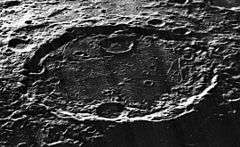Oppenheimer (crater)
|
Mosaic of LRO WAC images | |
| Coordinates | 35°12′S 166°18′W / 35.2°S 166.3°WCoordinates: 35°12′S 166°18′W / 35.2°S 166.3°W |
|---|---|
| Diameter | 208 km |
| Depth | Unknown |
| Colongitude | 170° at sunrise |
| Eponym | J. Robert Oppenheimer |

Oppenheimer is a large lunar crater that lies on the Far side of the Moon. It lies along the western outer rampart of the immense walled plain Apollo. Nearby features of note include the dark-floored crater Maksutov to the southwest, and Davisson to the west-southwest. The latter intrudes into the eastern rim of Leibnitz, a feature about 20% larger than Oppenheimer.
The outer rim of Oppenheimer is very nearly circular, but is broken in several locations by small craters. The most prominent of these is Oppenheimer H, lying against the inner wall and rim. In general the inner wall is unusually narrow along the western rim, but is much wider in the eastern half near where the rim approaches the Apollo basin. The interior floor is relatively level, particularly near the center. This floor has a lower albedo in several patches near the western rim. One of these patches contains the flooded crater Oppenheimer U. Near the northern and southern inner walls is a system of linear rilles in the surface. The far eastern half of the crater is marked by a ray system running north–south.
Satellite craters
By convention these features are identified on lunar maps by placing the letter on the side of the crater midpoint that is closest to Oppenheimer.
| Oppenheimer | Latitude | Longitude | Diameter |
|---|---|---|---|
| F | 34.7° S | 161.5° W | 35 km |
| H | 36.5° S | 163.1° W | 33 km |
| R | 37.3° S | 170.4° W | 26 km |
| U | 34.3° S | 167.9° W | 38 km |
| V | 32.0° S | 172.7° W | 32 km |
| W | 32.1° S | 169.0° W | 20 km |
References
- Andersson, L. E.; Whitaker, E. A. (1982). NASA Catalogue of Lunar Nomenclature. NASA RP-1097.
- Blue, Jennifer (July 25, 2007). "Gazetteer of Planetary Nomenclature". USGS. Retrieved 2007-08-05.
- Bussey, B.; Spudis, P. (2004). The Clementine Atlas of the Moon. New York: Cambridge University Press. ISBN 978-0-521-81528-4.
- Cocks, Elijah E.; Cocks, Josiah C. (1995). Who's Who on the Moon: A Biographical Dictionary of Lunar Nomenclature. Tudor Publishers. ISBN 978-0-936389-27-1.
- McDowell, Jonathan (July 15, 2007). "Lunar Nomenclature". Jonathan's Space Report. Retrieved 2007-10-24.
- Menzel, D. H.; Minnaert, M.; Levin, B.; Dollfus, A.; Bell, B. (1971). "Report on Lunar Nomenclature by the Working Group of Commission 17 of the IAU". Space Science Reviews. 12 (2): 136–186. Bibcode:1971SSRv...12..136M. doi:10.1007/BF00171763.
- Moore, Patrick (2001). On the Moon. Sterling Publishing Co. ISBN 978-0-304-35469-6.
- Price, Fred W. (1988). The Moon Observer's Handbook. Cambridge University Press. ISBN 978-0-521-33500-3.
- Rükl, Antonín (1990). Atlas of the Moon. Kalmbach Books. ISBN 978-0-913135-17-4.
- Webb, Rev. T. W. (1962). Celestial Objects for Common Telescopes (6th revised ed.). Dover. ISBN 978-0-486-20917-3.
- Whitaker, Ewen A. (1999). Mapping and Naming the Moon. Cambridge University Press. ISBN 978-0-521-62248-6.
- Wlasuk, Peter T. (2000). Observing the Moon. Springer. ISBN 978-1-85233-193-1.
